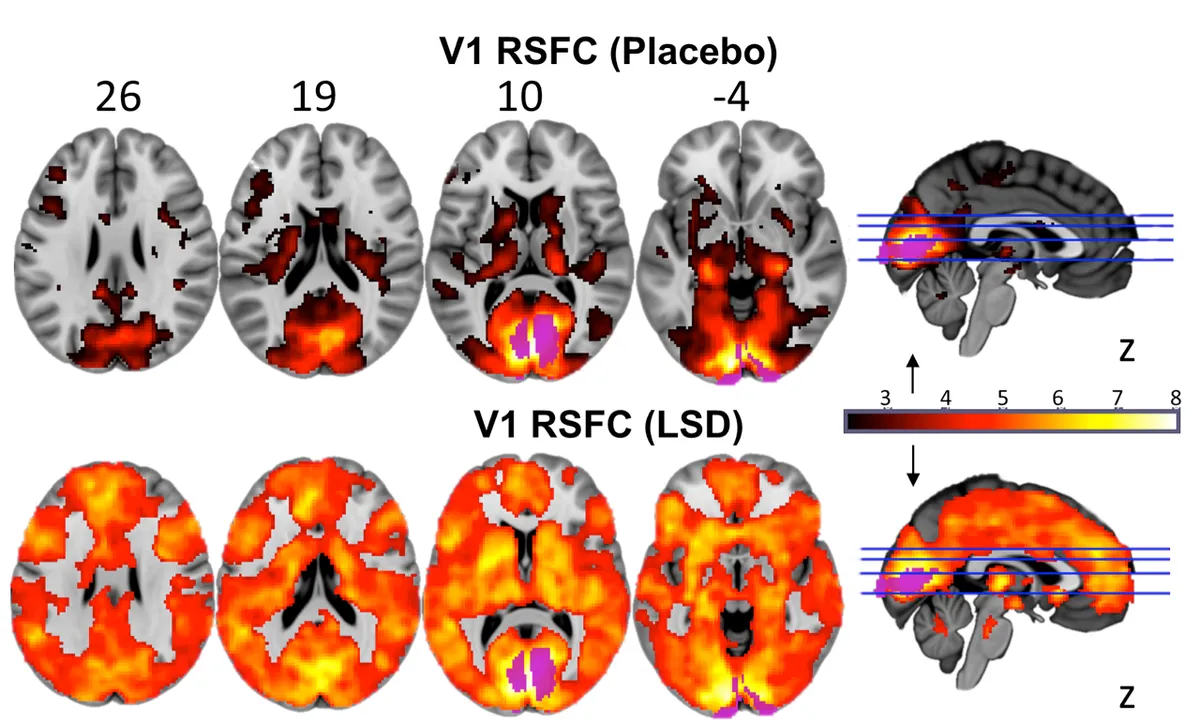According to Professor David Nutt of Imperial College in London, two things happened in 1943 that changed the world forever: The explosion of the first atomic bomb, and the birth of Lysergic acid diethylamide, also known as LSD – or, simply, acid. “These were two of the most important events of the twentieth century,” he says. “They genuinely changed western society - not many things have done that.”
Now, for the first time scientists have been able to glimpse what happens in the brain when we take LSD – more than seventy years after the drug was first synthesised. “The world has waited half a century for this,” says Nutt, who led the research, first conceived of by himand his team a decade ago. “In terms of a scientific study, this is the most difficult thing I’ve ever done.”
But not everybody shares Professor Nutt's views. Many membersof the scientific community have valid concerns about the drug'smedical applications and its potential to providetherapeutic benefits.
The start of the trip
The LSD story began when chemist Albert Hoffman was tinkering in the laboratories of Sandoz chemicals in Switzerland where he was developing drugs to treat post-partum hemorrhaging. When his fingers touched a bit of LSD-25, the world began to shimmer: “I perceived an uninterrupted stream of fantastic pictures, extraordinary shapes with intense kaleidoscopic play of colours,” he wrote in his diary. Intrigued, he decided on a “self-experiment” and dosed himself with 0.25mg of acid before riding home by bicycle. The world melted, and our understanding of the mind changed forever. That day – 19 April1943 – is today known as ‘Bicycle Day’.
Though the straight-laced Swissman had never dabbled in drugs before, he certainly did afterwards: he took the drug until he was 96 (and lived to be 102). “Albert was the happiest human I have ever known, I think because he realized what a gift he had given to mankind,” says Amanda Feilding, Founder of the Beckley Foundation, a drugs policy think tank. Feilding is a co-author of Nutt’s landmark study – realising the promise she made to Hoffman shortly before his death, that she would do her part to help his dream of seeing the brain on LSD.
With such profound capacity to change everything about the way we see, feel and think, Hoffman believed LSD could be an unparalleled tool for understanding the brain. For a time, his peers agreed: psychiatrists the world over-deployed the drug in their quest to understand the human condition.
Some thought it could be a tool to help them understand mental illnesses such as schizophrenia; LSD could allow physicians to spend a day experiencing what it means to be mad, enhancing their capacity to empathise with their patients. Others saw LSD as the opposite, a treatment for mental illness – a “test tube cure for madness”. Some gave the drug to artists and musicians, intrigued by its influence on their creations. And still others saw in LSD the potential to treat more quotidian human ailments – in particular, alcoholism. Thousands of people – including stars Cary Grant and Esther Williams, plus Bill Wilson (founder of AA) – used the drug in psychotherapeutic sessions to get to the root of the reasons they sought salvation at the bottom of a bottle.
Mind-altering substances
Of course scientists yearned to understand what went on underneath the hood, in the brain itself – but this was early days for neuroscience. Magnetic resonance imaging (MRI) scanners did not hit the scene for many years. A few studies measuring the electrical activity inside the brain using electroencephalogram (EEG) readings found reductions in the “oscillatory power” of brain waves under LSD – mysterious and intriguing. But before other scientists could delve deeper, research ground to a halt from 1966 as America and other countries banned the drug, relegating it to the status of “Schedule 1” (in the UK, “Class A”): having no accepted medical use. A chemical without the capacity to heal – or inform.
For decades scientists interested in the properties of the drug could only experiment on animals, which only taught us so much. (Case in point: mice on acid had no fear of cats. In return, cats on acid were terrified of mice. One paper describes a cat nursing a mouse from its mammary glands.) Slowly, legitimate studies of psychedelics began to reappear in the 1980s. In recent years, neuroscientists have been able to use the modern tools of brain imaging.

In 2012, Dr Robin Carhart-Harris – part of David Nutt’s team - published a study of the brains of people who had been dosed with psilocybin, the active ingredient in magic mushrooms. Perhaps counter-intuitively, he found that the drug decreased, not increased, the flow of blood to a constellation of structures known as the ‘default mode network’, considered by some to be the ‘seat of the self’. This implies, he says, that during normal consciousness those regions are crucial to keeping our experience of the world – and our sense of self – stable.
In Brazil, Dr Draulio de Araujo of the Brain Institute at the Federal University of Rio Grande do Norte (UFRN) has been studying the hallucinogenic brew ayahuasca. He has found that the drink, which contains the psychedelic DMT, also reduced blood flow to the default mode network in patterns similar to what is seen with psilocybin.
“This important because in depression we see the opposite pattern,” says de Araujo. “So this gives us clues as to the potential use of psychedelics as antidepressants. I truly believe that psychiatry will have a different perspective on these drugs in future years.” His own research has been relatively easy to carry out, as ayahuasca is legal in Brazil.
Conversely, few psychedelics have been as difficult to study as LSD, which caused widespread panic in the 1960s when it was feared that it could cause brain damage and psychosis. Retrospective studies published last year indicate the worries were unfounded, but at the time the fear was very real. To give some idea of how much the authorities worried about LSD, President Richard Nixon once called Timothy Leary “the most dangerous man in America” for encouraging mass LSD dosings. The stigma stuck, and though researchers have been able to study other psychedelics in the past 30 years, LSD remained largely out of bounds.
Scanning the brain on LSD
Carhart-Harris had first approached Nutt with ambitions to study LSD ten years ago – and Feilding had wanted to see the brain on LSD through a scientific lens for decades. “LSD is the jewel for researchers in a way, it is the prototypical psychedelic,” he says. It took them nine years to cross all the regulatory hurdles, and another two years to publish the findings.After waiting for so long, the team decided to get as much data as possible out of the 20 subjects – made slightly easier by the fact that an LSD trip lasts up to eight hours (twice as long as a magic mushroom experience). During the hour that each participant spent in the MRI scanner, the team deployed three different neuroimaging techniques to gather three forms of data. Then, with many hours to go, they scanned all 20 brains with magnetoencephalography, and put each subject through a raft of cognitive tests. The main paper, published in the journal PNAS today, is one of a raft of studies they will put out using information from the same 20 study people.
Which points to what many see as the great promise for psychedelic research: that it could hold the key to treating some of our most poorly treated condtions, from PTSD to depression and addiction. Prof Nutt certainly thinks they will, often describing the blanket ban on psychedelics as “one of the biggest missed opportunities in the history of medicine.”
Beyond scouring for the neurological data to support the idea of psychedelics as medicaments, Nutt says the ultimate purpose of this work is a slightly more lofty one: probing the nature of consciousness itself.
“This is core neuroscience. This is about humanity at its deepest level. It is fundamental to understanding ourselves. And the only way to study consciousness is to change it,” says Prof Nutt. “Psychedelics change consciousnessness in a way that is unique, powerful, and perpetual – of course we have to study them.”

Seventy years after the birth of LSD, what did they find? One, that two components of the default mode network – the paraphippocampus, and the retrosplenial cortex – became more disconnected from each other the more subjects experienced “ego loss”, implying that they together create a sense of self in normal waking consciousness. Perhaps more striking: brain networks become “desegregated”. Regions of the brain that do not normally communicate with each other suddenly do so to a profound degree.
“You get increased connectivity because you have dampened down the control centres,” explains Carhart-Harris. “If you think of the brain as a party hosted by a university, and you have all these departments: psychology, chemistry and so forth. They all keep to their clique, and there’s no cross talk. And if you want to come up with new ideas, there needs to be cross talk. LSD gets everyone talking to each other.”
“The brain becomes much more integrated in a strange sort of way,” elaborates Nutt. “You can pull together things that you wouldn’t normally. This is why LSD could be so powerful in treating conditions where the brain has become ‘locked in’, such as alcoholism or depression.”
A brave new world
Using LSD to treat depression – which Nutt and his team are investigating – is just one potential application for psychedelics that researchers are exploring: using psilocybin to help smokers quit, administering ketamine for intractable depression, and MDMA for trauma are just three of many ideas being explored. One of the most promising: using psychedelics to help with anxiety in terminal cancer patients. Hoffman himself had hoped the drug could “transform the experience of dying”. Aldous Huxley called for LSD to be brought to him on his deathbed.
Dr. Glen Hanson, former acting director of the National Institute On Drug Abuse in America – who has published over 150 scientific papers exploring how drugs such as cocaine and methamphetamine affect the brain – however thinks we should exhibit caution.
“This study doesn’t tell us much about the therapeutic value of this drug – though it may give us suggestions to investigate further,” he says.
In general, however, LSD is not a drug he would rush to endorse, despite the enthusiasm of proponents. “LSD is a very dirty drug, meaning that it is not particularly selective in what it does. As a result it can be problematic for patients with underlying psychiatric disorders. In pharmacology when we are trying to develop compounds as pharmacotherapeutics, you like them to be well targeted so the likelihood of side effects is substantially diminished.”
Certainly, most organisations that fund academic and medical research agree with Dr Hanson: acquiring funding to analyse the data from their scans was extremely difficult, leaving the team to turn to crowd-funding organisation Walacea to raise the money: 1628 people donated £53,390 to the cause (double the £25k that the team had asked for). “In a way this is kind of the people’s science,” says Carhart-Harris.
It took half a century to happen, and this is just the start, says Nutt: they’ve only just begun to scratch the surface.
Just how important will LSD be? Nutt thinks it will be “invaluable” in helping us understand the nature of the sober mind, consciousness, and the brain itself. “To paraphrase Isaac Newton: we can see further because we are standing on Hoffman’s shoulders.”